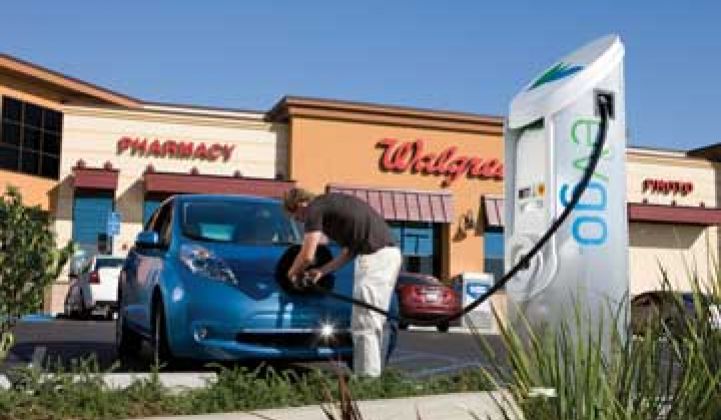If you own a national chain and you’re thinking about putting in electric vehicle chargers, you might want to give Walgreens a call.
The pharmacy has already learned a thing or two about electric vehicle chargers as it continues the process of installing 800 by the end of this year. For starters, the technology doesn’t have to be flashy, because people are using charge station finders in their car or on their smart phone -- rather than driving around aimlessly looking for signs that say “charge here.” Second, it doesn’t have to be right next to the door, but it also gets expensive if it’s too far away from the electrical room. Lastly, 480-volt DC charging is the way to go -- if you can get it.
Even just a year ago, DC fast charging, which can cut a full charge time from about four hours (level 2) to as little as fifteen minutes, seemed like a luxury that would be off in the future while level 2 (240V) would dominate the scene in the short term. Today, the bulk of chargers, both public and private, are 240V. But there are hundreds of DC chargers coming online in the next six months to a year. There will be 400 installed by ECOtality as part of the EV Project, and ABB recently acquired the Dutch company Epyon B.V. for fast charging.
Walgreens first got interested in offering electric vehicle charging when it was approached by NRG Energy to be a partner in its Freedom Charging Network in Texas. Earlier this year, NRG Energy announced it would install 70 DC charging stations in the Dallas/Fort Worth area and another 50 in Houston. (Only a fraction of those will be at Walgreens locations.) With a 'go big or go home' attitude, Walgreens decided this was one way to set itself apart. “We realized the value from a competitive standpoint to be the first mover,” said Menno Enters, director of energy and sustainability at Walgreens.
Although Walgreens is enthusiastic about DC charging, it is installing only about 150 nationwide because of limitations -- but not financial ones. “We wanted to maximize DC charging,” said Enters, “but our power infrastructure is not set up to have DC charging.”
Even if the bulk of the chargers are level 2, Enters said those could still offer a top off, even if it's not a fill up. Also, as more utilities get on board, there could be upgrades down the road to allow for more DC stations. Enters said that when they started calling utilities about electric vehicle charging, few were interested, and now they’re calling back asking to have Walgreens participate in EV charging pilots.
The firm 350Green, one of Walgreens' partners for installing the chargers, also just announced a separate project for 73 fast chargers in the Chicago area. Mariana Gerzancyh, CEO and co-founder of 350Green, said her company has not had constraints for DC charging -- but that’s because 350Green is coordinating with local utilities from the start to identify suitable locations for the stations. Walgreens, on the other hand, does not have the liberty of picking up its stores and moving them to a spot where DC charging would be ideal. Coulomb Technologies, which offers EV charging, does not have any DC fast chargers yet, but there will be some installations late this year or in early 2012. AeroVironment is also installing dozens of fast chargers in the Pacific Northwest in 2012.
Eight hundred chargers make Walgreens by far the current leader, and if they hit their target of 20 percent being DC chargers, they will also be a retail leader in fast charging. But others could be close behind. “Since they stepped into the space, we are getting a tremendous number of inquiries about installation at other retailers,” said Gerzancyh. Walgreens said it is also hearing rumors of others following in its footsteps.
To keep up with demand, 350Green just placed an order for 900 level 3 DC fast chargers from Efacec, with 145 being delivered this year. Walgreens is working with 350Green and is assessing other charging companies in each locality for the rollout. There are no immediate plans to expand beyond the initial 800 chargers in 2012; rather, the company is adopting a 'watch and wait' approach as more EVs take to the road. “We have set out the bait and now we have to wait for the fish to bite,” said Enters. “We’ve had district managers ask about getting one, maybe dozens, because people are asking if we’ll have charging if they get an electric car.”
For more about the electric vehicle market, join us on October 20 for The Networked EV conference in San Francisco.



